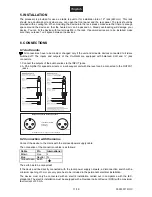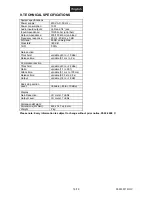
00033011.DOC
15/19
4. DESCRIPTION
The
OMNITRONIC CL-266
was designed for professional applications. The inputs and outputs are
located on the rear panel, the control elements on the front panel. The
CL-266
has two identical channels.
Each channel is equipped with eight controls and 16 LEDs. Additionally, the STEREO/LINK button is for
stereo operation of the unit and the BYPASS switch allows for the direct comparison between the
unprocessed and the compressed or limited signals.
■
Power switch
with indicator
Turns power to the processor on and off. Be sure to
power-up before your power amplifier is turned on to
avoid loud transients which could damage your speakers
or annoy your audience. When powered on, the indicator
lights up.
Gate section
A noise gate is a signal processor that turns off or
significantly accentuates the audio signal passing through
it when the signal level falls below a user adjustable
threshold.
■
Gate Closed LED
This LED lights up if a signal below the adjusted value is
applied and thus the gate is processing. When the signal
gain is above the adjusted value again, the LED turns off.
■
Threshold control
Use this control to determine the threshold point below
which expansion occurs and the signals below threshold
are reduced in gain. The range of this control is from -45
dB (OFF) to +10 dB. Signals above this threshold value
pass unaltered. Adjust this control so that music signals
can pass but the noise is faded out. In OFF position, all
signals are allowed. By turning it clockwise only signals
over the threshold are allowed to limit the noise signal
level.
How to set a proper gate level for most applications?
Turn off the gate threshold. Turn on all instruments
hooked to this unit but no input is allowed. Increase the
threshold, the GATE CLOSED LED comes on. This is
helpful in removing hiss from tape, guitar amps etc.
■
Release control
To optimally adapt the gate to the program material,
adjust the RELEASE control to determine the rate at
which the gate closes once the signal falls below the
threshold. This control can be adjusted from 0.1 to 2.0
seconds. Use faster release values to process percussive
material with little or no ambience. Use slower release
values for signals with long decay or heavy ambience.
■
Gain Reduction LED meter
Displays the attenuation by the compressor within a
range from 1 to 24 dB.
Compressor/Limiter section
The task of limiters is to reduce the dynamic range of the
program material and to control the overall level. It
prevents signals from exceeding a given threshold level.
The extent of the resulting dynamic level is dependent on
Threshold, Attack, Release and Ration settings. A
compressor also monitors the program material
continuously and has a certain threshold level. However,
in contrast to the limiter, signals are not reduced in level
abruptly once the threshold has been exceeded, but are
returned to the threshold gradually.
■
Threshold
control
This control sets the threshold point for the compressor
section. It has a range of -40 to +20 dB. Signals above
the threshold are reduced in gain, relative to the amount
the signal exceeds this point.
■
Ratio control
This control determines the ratio between the input and
output level for all signals exceeding the threshold point
by more than 10 dB. The control range can be adjusted
form 1:1 to oo :1. A setting of 1:1 leads to no compression,
turning the control clockwise makes the sound
increasingly dense. A setting of oo :1 corresponds to a
limiter setting. The figure below explains the comparison
of compressed signals responding to various ratio
settings:
Содержание CL-266
Страница 2: ......



















